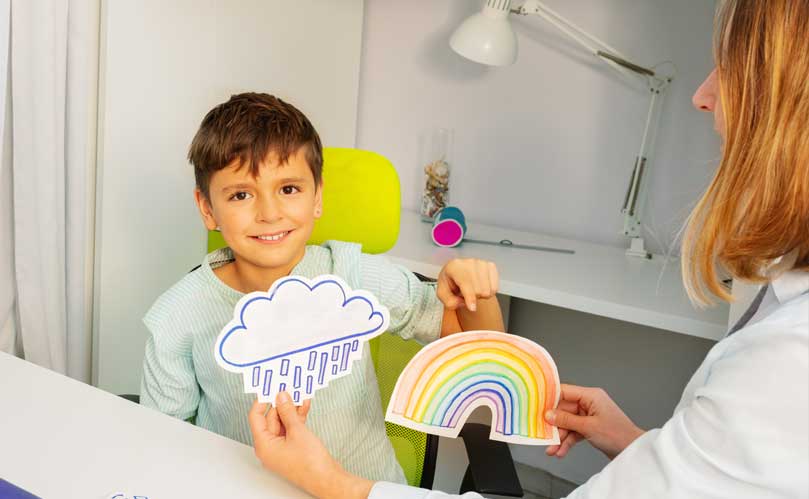Is ABA Right for Our Family?
ABA Therapy is effective If your child is having difficulty learning, acquiring critical skills, having trouble communicating and exhibiting problem behavior that gets in the way of functioning.
Research comparing ABA with other therapy and education programs shows that children who receive ABA treatment make greater improvements in more skill areas than children who participate in other programs. In one long-lasting research study of ABA Therapy, results showed that 90% of the test children substantially improved their learning and communication skills.
ABA is considered an evidence-based, best-practice treatment by the U.S. Surgeon General and by the American Psychological Association. This means that ABA has passed scientific tests of its usefulness, quality and effectiveness.

ABA FAQ
Applied Behavior Analysis (ABA) Therapy is a scientific method of observing behavior, teaching new social skills and decreasing any problem behavior (tantrums, hitting, screaming, etc.) in those with Autism Spectrum Disorder.
ABA Therapy is typically sought for early interventions with young children. But older children and adults on the spectrum can benefit from ABA Therapy as well, and treatment options for them are often scarce. Government assistance typically ends at age 22.
ABA Centers of America Works Toward the Following Goals:
- Learning critical life skills
- Introducing alternatives to unwanted behavior
- Building up inherent strengths
- Developing social, communication and language skills
Whether the client has had ABA Therapy in the past or is new to the idea, Applied Behavior Analysis can offer new skills to deal with real-world challenges. Our adult programs are designed to give clients confidence by working toward agreed-upon goals for independent living, handling social gatherings, cooking and more.
ABA therapy is also effective in developing “soft skills,” like nonverbal communication, understanding other people’s perspectives, and working in a team.
ABA Therapy can help improve:
- Academics
- Cooking and cleanings
- Fitness
- Home living
- Workplace training
- Social skills
- Self-care
- Attention, focus and memory
- Cognitive skills
- Health management
One study showed that after ABA therapy, 90% of children substantially improved and 47% of them were able to function as well as other students in traditional classroom settings. There are more than 550 studies published in scientific journals on the success of ABA therapy.
Research on ABA therapy as a form of autism care began in the 1960s, and since 1981 ABA has been identified as the most effective treatment for autism.
ABA is endorsed by the U.S. Surgeon General, Autism Society of America, National Institute of Mental Health, American Psychological Association and many other organizations and agencies.
ABA can help manage lifestyle challenges for children and adults with autism or other mental and physical health conditions. Other conditions it can treat include anxiety, anger issues, dementia and substance abuse.
A typical course of ABA therapy involves 20-40 hours per week for 1-3 years. However, the number of hours of therapy can differ depending on the client’s goals. ABA therapy programs are designed by our Board-Certified Behavior Analysts (BCBAs) and conducted by our Registered Behavior Technicians (RBTs). Both are governed and licensed by the Behavior Analyst Certification Board (BACB). Generally, the main steps are:
- Initial Assessment—skills and abilities are measured
- Goal Setting—specific, reachable objectives are set to address desired skills
- Custom Planning—a program is developed to teach target skills in a natural environment
- Evaluation—measuring targeted skills and making changes to the program if necessary
A BCBA oversees the treatment program. They conduct assessments and use the results to create a custom therapy plan. They also assess results from sessions and modify treatment plans to meet client goals.
BCBAs study behavioral psychology and have a master’s degree in Applied Behavior Analysis. They also have spent 1500 hours as a therapist under qualified supervision. The certification exam is no cakewalk and has only a 50% pass rate. Be assured that our BCBAs are professionals you can trust with your child’s treatment.
An RBT works directly with the client on therapy. These ABA therapists put in place the behavior plans developed by the BCBA. They collect critical data and develop a quality relationship with the client and the family.
- A few of the RBT’s specific responsibilities include:
- Implementing measurement procedures
- Assisting with assessments
- Carrying out therapy plans
- Communicating with the family and the supervising BCBA


